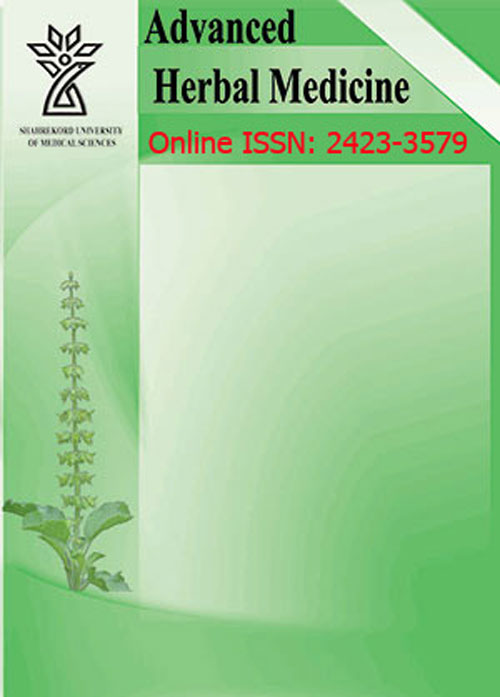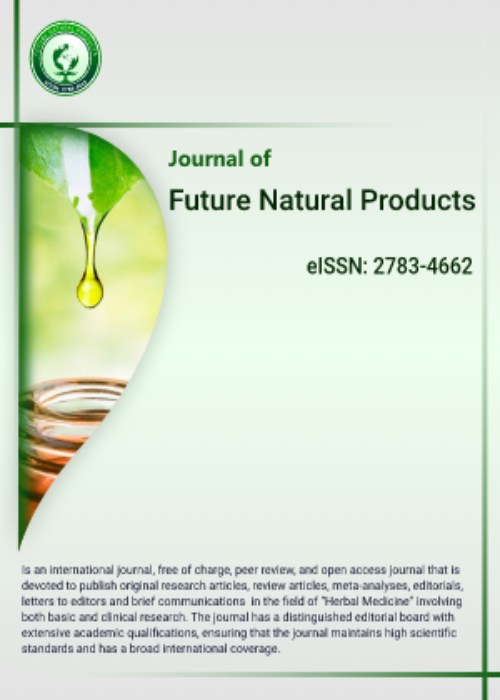فهرست مطالب

Future Natural Products
Volume:2 Issue: 3, Summer 2016
- تاریخ انتشار: 1395/09/17
- تعداد عناوین: 8
-
Pages 1-4Background And AimsScleroderma is a systemic autoimmune disease that its core symptom is hardening (Sclero) of the skin (Derma). It also affects other internal organs in more severe cases. This illness has high morbidity and mortality and it can disrupt the normal function of the patient. Immunosuppressors and many other drugs have been used to treat but different adverse side effects of these treatments make them unsafe; Therefore, since there is no definite cure for scleroderma. In modern medicine, traditional medicine treatment strategies to patient's relief can improve quality of life, decrease morbidity and mortality of the disease and decrease the various side effects of drugs in modern medicine treatment.Case PresentationIn this article, it was reported a 38 years old woman, known case of scleroderma who improved dramatically with traditional medicine methods after a short term course of treatment.ConclusionScleroderma is a complex disease which has no definite cure in modern medicine. Traditional treatments can improve many annoying symptoms of the disease.Keywords: Scleroderma, Raynaud's phenomenon, Melancholia, Cholera, Traditional Medicine
-
Pages 5-12Background And AimsMedicinal plant products are considered to be an effective candidate against the number of viral diseases as generally observed or reported in developing countries. As per the literature, secondary metabolites (i.e. Alkaloids, flavonoids, saponins etc.) are reported in medicinal plant products and showed its antiviral properties. In this study, our group focused on those medicinal plants especially roots of Ficus benghalensis and Ficus racemosa related to New castle Disease Virus (NDV) and Infectious Bursal Disease (IBD) having in vitro antiviral activity. These studies were conducted on the human peripheral blood mononuclear cells (PBMC).MethodsFor antimicrobial studies, different medicinal plant products especially roots of Ficus benghalensis and Ficus racemosa were collected from Vidya Pratishthans garden, School of Biotechnology, Baramati. These medicinal plant leaves are used in the form of aqueous extract and determined its anti-microbial activity against poultry viruses (i.e. NDV and IBD) in PBMC and determined proliferation assay, Th1 (TNF alpha) cytokine production and CD14 monocyte surface marker.ResultsThree medicinal plant aqueous extracts showed noteworthy antimicrobial activity with respect to decline in proliferation assay, TNF alpha production and CD14 monocyte surface marker in human PBMC as compared to control.ConclusionSome of the medicinal plant products have shown antimicrobial activity. Further immunobiological research is mandatory to elucidate the most active constituents that are present in these aqueous extracts which may be useful or target molecule in the development of new effective and safe antiviral agents.Keywords: Ficus benghalensis, Ficus racemose, Antimicrobial, NDV, IBD
-
Pages 13-19Background And AimsNosocomial infections are the main cause of the problems related to health and health care costs. One of the pathogens that causes these infections is Staphylococcus aureus. Its resistance to antibiotics forced researchers to find herbal substitution such as Sesame and Olive. This study was aimed to determine antibacterial effect of sesame oil, olive oil and their synergism on S. aureus.MethodsIn this experimental study, at first, olive oil and sesame oil was extracted by cold press assay and the mixture of them was prepared with equal proportion of both oils, and then the standard strain of lyophilized S. aureus ATCC 25923 was prepared from the Iranian Research Organization for Science and Technology. To determine minimum inhibitory concentration (MIC) and minimum bactericidal concentration (MBC) of the oils, micro-broth dilution method was used.ResultsThis study indicated the amounts of MIC for sesame oil, olive oil and their synergism; 32 mg/ml, 32 mg/ml, 8 mg/ml and the amounts of MBC; 128 mg/ml, 128 mg/ml, 32 mg/ml, respectively.ConclusionThe results showed the same antibacterial activity for olive oil and sesame oil. It also showed that mixture of these oils enhances the growth inhibitory and bactericidal properties of the oils compared to using them individually.Keywords: Staphylococcus aureus, Olive oil, Sesame oil, Synergism
-
Pages 20-32Background And AimsHypertension is one of the most common causes of cardiovascular and cerebrovascular complications in human which take care requires permanent monitoring and lifelong treatment. Therefore, patients use herbal medicine to manage their disease. This study was conducted to list the medicinal plants used to manage hypertension in municipality of Ouémé, Southern Bénin.MethodsThe survey was conducted by oral interviews using a structure questionnaire. These questionnaires were administered to randomly selected vendors, traditional medicine practitioners and person resource. The specimen of each species was deposited at the National Herbarium of the University of Abomey-Calavi and the Relative Frequency Citation was calculated.Results77 plants belonging to 46 families were recorded for the treatment of hypertension in department of Ouémé. 37 antihypertensive recipes were identified. Caesalpiniaceae, Annonnaceae, and Rubiaceae were the most represented. Allium Sativum was the most used species against hypertension with relative frequency of citation of 0.155 following by Persea americana (RFC= 0.134). The most parts used was aerial part (23.08%) followed by the leaves (21.98%). The principal mode of used is decoction (72.35%) and the main mode of administration was the oral route.ConclusionThe survey enables to indicate plants species used to manage hypertension in department of Ouémé. The document resulting from this study is an effective way to preserve knowledge in traditional medicine. However, pharmacological screening of these plant species is very important to check their effectiveness.Keywords: hypertension, Medicinal plants, Southern Bénin
-
Pages 33-38Background And AimsHumans always have been considered the use of medicinal plants in the treatment of diseases because of fearing the side effects of chemical drugs. The current study aimed to identify the essential oil of Myrtus communis L. collected from natural habitats province of Khuzestan and Kohkiluyeh and Boyer-Ahmad.MethodsIn this experimental study, Myrtus communis L. was collected from Khuzestan and Kohkiluyeh and Boyer-Ahmad in July 2015. Plant material was identified by Ramin Agriculture and Natural Resources University of Khuzestan. 50 gm of cleaned and dried plant material was powdered and pestle and placed in a round bottom flask fitted with condenser hydro distilled for 3hrs at atmospheric pressure and constant temperature. The strongly aromatic oil was separated from the water layer using n-Hexane and the solvent was removed by boiling. The component identification was achieved by the GC-MS analysis.Total GC running time was 75 min.ResultsPhytochemical analyses of the essential oil collected from samples were contains 31 combinations. Secondary compounds in essential oils were including: α-Pinene, 1,8-Cineole, Limonene, Linalool L, α-Terpineol, Linalyl acetate, Geranyl acetate. α-Pinene and 1,8-Cineole were highest percentage of compositions. α-Terpinene combination was only existed in Kohkiluyeh and Boyer-Ahmad samples and Limonene combination was only existed inKhuzestansamples.ConclusionThe α-Pinene and 1,8-Cineole are two dominant component in the essential oil of Myrtus communis L. in studied samples. Considering the effect of environmental factors on metabolites in medicinal plants identifying the metabolites in this medicinal and commercial plants will increase cost-effectiveness.Keywords: 1, 8, Cineole, ?, Pinene, Essential oil of Myrtus communis L
-
Pages 39-46Background And AimsUrinary tract infections (UTIs) are one of the most common and the second leading infections, after respiratory tract infections, in women. Currently, various chemical drugs are used to prevent the UTIs. Chemical drugs may cause antibiotic resistance and cause resistant strains likely grow in the long-term treatment with antibiotics. The aim of this study was to investigate the effect of Cornus mas in preventing recurrent UTIs in women aged 15-45 years referring to Ayatollah Kashani Hospital Clinic in Shahrekord.MethodsThis experimental study (Parallel Design and Triple-blind) was conducted on 42 women aged 15-45 years referring to Ayatollah Kashani Hospital Clinic of Shahrekord and diagnosed with chronic cystitis. The exclusion criteria were neurogenic bladder, genitourinary system anatomical abnormalities (hydronephrosis, ureterocele stone, etc), and bacterial resistance. The women were randomly assigned to 2 groups. At baseline, the women were examined for any functional and anatomical disorders and if it was necessary, they underwent ultrasound. After the current UTIs were treated and the women clinically recovered, one group was administered with Cornus mas tablet 500 mg and another group administered with placebo for 6 months. All the women were followed up for 6 months. Every 2 months, the patients were clinically examined and their urine cultures were investigated for the clinical signs of cystitis. As the symptoms of the UTIs occur, the patients were recommended to refer for repeated urine culture. All patients (42 women) completed the study.ResultsIn our study, no significant difference was observed between the groups in terms of recurrent UTI recurrence, although there were differences (P>0.005). Positive urine culture in Cornus mas group was 19% and in placebo was 33.4%. In terms of dysuria in 6 months and the second time, there was a significant difference between placebo and Cornus mas (P=0.004) Dysuria in Cornus mas group was 14.2% and in placebo was 56.2%.ConclusionCornus mas can decrease dysuria and frequent urination in patients with recurrent UTIs, so it can be used in the treatment of these patients.Keywords: Cornus mas, Urinary tract infections, Treatment
-
Pages 47-60Background And AimsAloe vera has been used medicinally for several thousands of years in many cultures from Egypt, Greece, and Rome to China, India, and etc. Although Aloe barbadensis propagates vegetative manner in its natural state, but propagation is too slow for commercial plant production. To overcome slow propagation rate, micropropagation will be a very useful technique for mass multiplication of Aloe vera. The aim of this study was to investigate and establish an effective method for aseptic micropropagation of Aloe vera.MethodsThis researchwas an experimental study that was conducted in tissue culture lab, Department of Genetics and Plant Breeding, BHU, Varanasi, India to develop a protocol for surface sterilization of Aloe vera explants. 42 treatments carried out for the shoot tip, apical meristem and rhizome discs of Aloe explant.ResultsUsing of Tween 20 (5 drops) for 10 mints, Bavistin 1% for 10 mints and NaOCl (1.0%) for 6 minutes followed by rinsing sterilized distilled water showed the higher survival explants (70%) and asepsis was 81% and just 11% percent of the explants contaminated after 2 weeks. But the highest survived explants was for Tween 20 (5 drops) 10 minutes, Bavistin 1%; 10 minutes and Ca(ClO)2 (3.25.0%) 6 minutes (77% survival) and asepsis was 81% and only 11% of the explants contaminated after 2 weeks.ConclusionIn the present study, calcium hypochlorite with the highest asepsis, survival of explant and normally growth were more suitable than sodium hypochlorite for surface sterilization of Aloe vera.Keywords: Aseptic technique, Micropropagation, Aloe vera
-
Pages 61-67Background And AimsFenugreek (Trigonella foenum-graecum) is a medicinal plant with potential applications in the medicinal purposes. Fenugreek has been used in food as a flavouring agent since ancient times in many countries like Greece, Rome and Egypt. It has a special place in the traditional medical system. The aim of this study was to review phytochemistry and pharmacological effects of Trigonella foenum-graecum.MethodsThis research was a review study. Data were collected using articles in various databases and books about pharmacological effects of Trigonella foenum-graecum.ResultsThe seeds are rich sources of lipids, protein, mucilage, calcium, dietary fiber B vitamins, Iron, protease inhibitors and several steroid saponins, tiny amounts of alkaloid, furostanol glycosides and steroidal peptide. As a medicinal plant, fenugreek recognized as a galactagogue or lactation stimulant in women after child birth as well as for its ability to treat wounds and sore muscles. In addition, it has the ability to be as antibacterial, anti-ulcer, anti-cancer, anthelmintic (antagonistic effect against parasitic worms), and antinociceptive (pain-reducing) properties. In recent years, laboratory studies and clinical trials have focused on the potential activity of fenugreek as a natural medicine.ConclusionThese studies have shown that fenugreek plants possess immunomodulatory, hypocholesterolaemic, hypoglycaemic, gastro- and hepatoprotective and antioxidative properties. Pharmacological properties of fenugreek have been explored to identify a role for the plant in diabetes management and in cardiovascular health, indicating the presence of bioactive compounds in fenugreek, which may be responsible for its health benefits.Keywords: Fenugreek, Galactagogue, Antinociceptive, Hepatoprotective, Hypoglycaemic, Antioxidative


